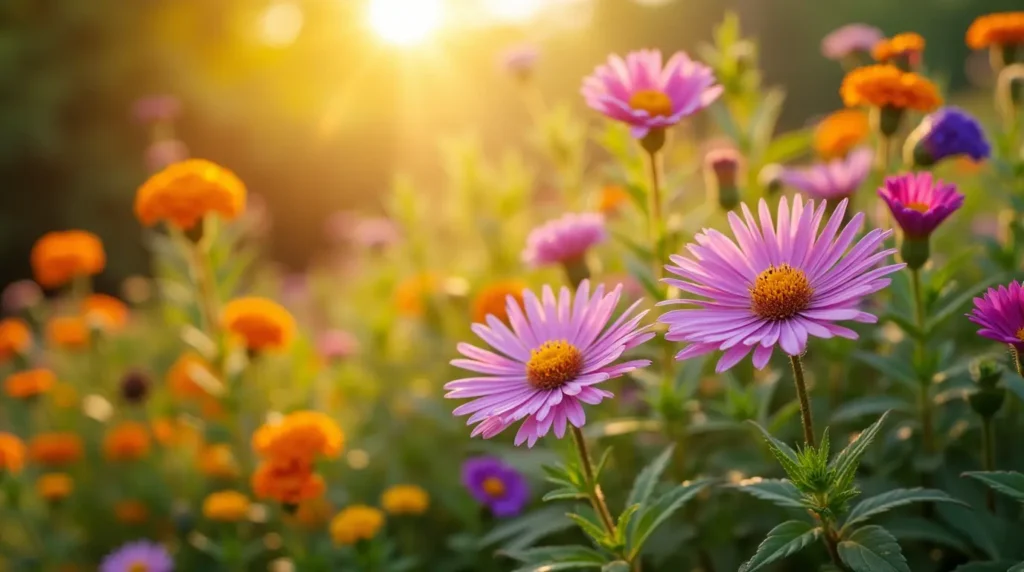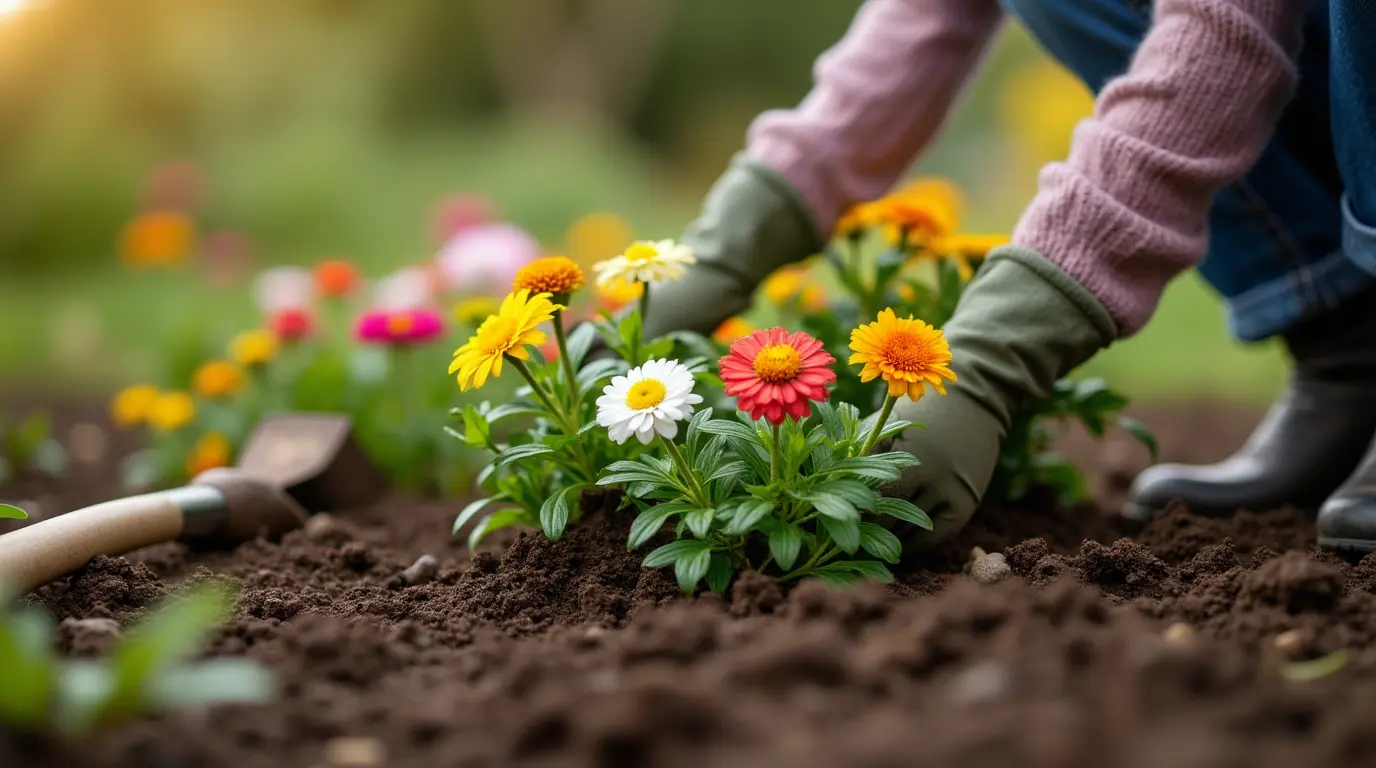Table of Contents
As summer’s warmth fades and autumn’s cool air arrives, September blooms with vibrant flowers. From the classic aster to the captivating morning glory, these flowers bring stunning colors and meanings. This guide will help beginners grow September flowers, sharing key tips for a thriving garden.
Key Takeaways
- Discover the significance and cultural meanings behind September’s primary and secondary birth flowers.
- Learn the essential growing conditions required for September flowers to thrive.
- Gain practical tips on preparing your garden, selecting the right varieties, and planting September flowers.
- Explore maintenance and care strategies to ensure healthy growth and bloom.
- Uncover solutions to common challenges, such as pest management and disease prevention, for successful September flower cultivation.
Understanding September’s Birth Flowers and Their Significance

As summer ends and autumn starts, September brings a colorful celebration of birth flowers. The september birth month flower is special for those born in this time. Let’s explore the primary and secondary September birth flowers, Aster and Morning Glory, and their meanings.
Aster: The Primary September Birth Flower
The aster comes from the Greek word for “star.” It’s the main flower for September. These flowers have star-shaped petals and symbolize love, patience, and grace. Asters come in many colors, from soft pastels to bright ones, making them perfect for September celebrations.
Morning Glory: The Secondary September Birth Flower
The morning glory is the secondary flower for September. It has trumpet-shaped petals that open with the sun. These flowers represent love, the shortness of life, and the beauty of fleeting moments. Their short life and beauty make them a meaningful addition to the September flower.
Cultural Meanings and Symbolism
Asters and morning glories have deep cultural meanings. Asters are often seen as symbols of:
- Fidelity and love
- Wisdom and patience
- Daintiness and elegance
Morning glories are linked to:
- Affection and unrequited love
- The fragility and transience of life
- Mortality and the cycle of birth and death
These meanings make the september birth month flower a thoughtful choice for celebrations.
Essential Growing Conditions for September Flowers
To grow vibrant september flowers, you need to know their special needs. This includes the right soil and sunlight. Making the perfect spot is key for these autumn blooms to do well.
The soil is crucial for september flower of the month growth. These flowers love soil that drains well and is rich in nutrients. The soil should be slightly acidic, between 6.0 and 6.8 pH. Adding compost or aged manure can help with drainage and nutrients.
Sunlight is also very important. September flowers do best in full sun, needing at least 6 hours of direct sunlight a day. Make sure your garden gets enough sun to have bright blooms.
Temperature and humidity are also important. These plants like moderate temperatures, with days between 70°F and 85°F and cooler nights. Keeping the soil moist and avoiding big changes in humidity helps them grow well.
By knowing and meeting the needs of september flowers, gardeners can make a beautiful display. This celebrates the autumn season’s beauty.
Preparing Your Garden for September Flower Planting
To grow a lively garden of september flowers, you need to prepare well. Start by making the soil right and picking the best spot. This hard work will help your september birth flowers bloom beautifully.
Soil Preparation Techniques
Good soil is key for your september flower garden. Make sure it drains well, is full of nutrients, and has the right pH. Add compost or aged manure to make the soil better. Also, aerate the soil to help roots grow strong.
Ideal Garden Location Selection
Find a spot that gets the right amount of sunlight for your september flowers. Most love full sun, but some like partial shade. Think about wind, water, and how easy it is to care for and pick your flowers.
Required Tools and Materials
- Gardening trowel or spade
- Rakes and hoes for soil preparation
- Watering cans or hoses
- Plant labels or markers
- Organic fertilizer or compost
With the right soil, location, and tools, you’re ready to create a stunning september flower garden. It will add beauty and happiness all season long.
Popular September Flower Varieties to Grow

As September nears, gardeners and flower lovers look forward to the september flowers blooming. This section highlights some top september month flower varieties for your garden. Each offers special traits and beauty.
The Aster is a standout september flower. These daisy-like flowers have many colors, from soft pastels to bright, bold ones. Asters last long and grow well in different conditions, making them great for September gardens.
The Zinnia is another favorite september month flower. Zinnias have lots of colors, like bright reds, oranges, and yellows. They add energy to any garden or flower arrangement.
- Marigolds: Bright and bold, marigolds are a classic september flower that thrive in sunny locations.
- Cosmos: These airy, delicate blooms come in shades of pink, white, and lavender, creating a dreamy and romantic atmosphere.
- Sunflowers: The iconic september month flower, sunflowers are sure to brighten any garden with their cheerful, radiant faces.
Looking for vibrant, lasting blooms or delicate, ethereal flowers? This September, add these versatile and captivating september flowers to your garden. They will create a stunning display that will delight your senses.
Step-by-Step Guide to Planting September Flowers
Planting september flowers needs careful attention. But with the right steps, your garden will bloom beautifully. Let’s explore the key steps to start your september birth flowers journey.
Planting Depth and Spacing
Planting september flowers right is important. Plant them 2-3 times deeper than their size. Leave 6-12 inches between each plant for growth and air.
Watering Requirements
- New september flowers need steady water to grow roots.
- Water deeply until the soil is moist but not too wet.
- Later, water about 1-2 inches a week, based on weather.
Timing Your Planting
Timing is key for september flowers. Plant in late spring or early summer. This lets them grow strong before autumn.
| Planting Depth | Spacing | Watering Needs | Planting Time |
| 2-3 times the seed/bulb diameter | 6-12 inches between plants | Consistent moisture for establishment, 1-2 inches per week as mature | Late spring/early summer |
Follow these steps for a stunning september flowers display. Happy planting!
Maintenance and Care Tips for Healthy Growth
To grow vibrant september flowers, you need to care for them well. Whether it’s september birth month flowers like asters or morning glories, these tips will help. They ensure your plants stay healthy and strong.
Watering Needs
Watering is key for your september flowers. Keep the soil moist but not too wet. Water deeply to reach the roots, but let the top inch dry out before watering again. Change your watering schedule based on weather and how fast your plants grow.
Fertilization
Give your september birth month flowers a balanced fertilizer every two to three weeks. This helps them grow well and bloom more. But don’t overdo it, as too much fertilizer can harm your flowers.
Deadheading and Pruning
- Deadhead your september flowers often to keep them blooming.
- Trim back any damaged or overgrown leaves to keep your garden looking neat.
- Lightly trim your plants to shape them if you want.
By following these care tips, your september flowers will thrive. They’ll add color to your garden for a long time.
Common Challenges and Solutions in Growing September Flowers
The september flowers add a warm, autumnal charm to gardens. But, growing them can be tricky. Gardeners face challenges like pests and weather issues. They need the right strategies for these seasonal blooms to thrive.
Pest Management Strategies
Pests like aphids, spider mites, and thrips can harm what is the flower for september. To fight these pests, gardeners can use eco-friendly methods:
- Regularly check plants for pests and remove affected parts.
- Use insecticidal soaps or horticultural oils to kill pests safely.
- Attract natural predators like ladybugs and lacewings to eat pests.
Disease Prevention Methods
September flowers can also get diseases like powdery mildew and root rot. To prevent diseases, gardeners should:
- Keep plants well-spaced for good air circulation.
- Don’t overwater and keep leaves dry to stop disease spread.
- Use fungicides as needed, following the instructions.
Weather-Related Issues
The september weather can be unpredictable. It can cause temperature changes, heavy rain, or drought. To handle these, gardeners should:
| Issue | Solution |
| Late-season frost | Use row covers or cloches to protect plants from frost. |
| Excessive rain | Ensure proper drainage and avoid overwatering. |
| Drought conditions | Water plants regularly and mulch to keep soil moist. |
By tackling these common challenges, gardeners can grow healthy and vibrant september flowers.
Harvesting and Using Your September Flowers
As summer ends, the september flowers in your garden bloom beautifully. They offer a wide range of colors and textures. Learning how to harvest and use these blooms is the real joy.
Timing is key when harvesting september flowers. The best time is in the early morning. This is when the stems are firm, and the petals are fresh.
Use sharp, clean scissors or pruners for a clean cut. Cut just above a healthy leaf or side shoot. Leave a few inches of stem attached to the flower.
- Avoid cutting flowers during the heat of the day, as they may wilt more quickly.
- Handle the delicate blooms with care, avoiding any unnecessary handling or bruising.
- Immediately place the cut stems in a clean container of water to prevent wilting.
After harvesting, september flowers can brighten up your home. They’re perfect for bouquets or unique arrangements. You can also dry them for decorations or infuse oils and lotions with their scent.
With a bit of creativity, you can enjoy your september flower of the month harvest fully. Follow these tips to enjoy these seasonal wonders long after they’re cut.
Conclusion
As we wrap up our guide on growing September flowers, it’s clear they hold a special place in many hearts. From the captivating Aster to the delicate Morning Glory, these flowers bring stunning colors and textures. They can turn any garden into a beautiful oasis.
Whether you’re a seasoned gardener or just starting, growing September-flowers is all about understanding their needs. Proper soil and care are key. Follow the steps in this guide to create a beautiful display that will delight and hold meaning for those with September birthdays.
Starting your journey with September birth flowers is exciting. It brings joy and a sense of accomplishment. Embrace the process, learn from any challenges, and enjoy the beauty these flowers add to your garden and life. With the right knowledge and dedication, you’ll create a stunning floral celebration that will be cherished for years.
FAQ
What is the primary September birth flower?
The primary September birth flower is the Aster.
What is the secondary September birth flower?
The secondary September birth flower is the Morning Glory.
What are the cultural meanings and symbolism associated with September birth flowers?
Asters symbolize love, wisdom, and faith. Morning Glories represent affection, mortality, and the fleeting nature of life.
What are the ideal growing conditions for September-flowers?
September-flowers need well-drained soil and full sun. They also prefer moderate temperatures. Make sure they get the right amount of water to avoid too much moisture.
How should I prepare my garden for planting September-flowers?
Start by amending the soil with compost. Choose a sunny spot. Then, gather your tools and materials for planting.
What are some popular September-flower varieties to grow?
Popular September-flowers include Asters, Morning Glories, Marigolds, Zinnias, and Cosmos. Each variety has its own beauty and charm.
When is the best time to plant September-flowers?
Plant September-flowers in the spring or early summer. This lets them grow and bloom in September.
How do I maintain and care for healthy September-flowers?
To keep September-flowers healthy, water them regularly. Fertilize them often. Remove dead blooms and watch for pests or diseases.
What are some common challenges in growing September-flowers, and how can I address them?
Challenges include pests, diseases, and weather issues. Use pest control, prevent diseases, and adapt to weather to overcome these problems.
How can I harvest and use my September-flowers?
Harvest September-flowers by cutting stems at the right length. Preserve the blooms. Use them in arrangements, bouquets, or decor.

